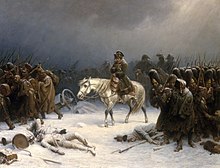
Back Hipotermie Afrikaans انخفاض درجة الحرارة Arabic Hipotermiya Azerbaijani Гіпатэрмія Byelorussian Пераахаладжэньне BE-X-OLD Хипотермия Bulgarian অবোষ্ণতা Bengali/Bangla Hipotermija BS Hipotèrmia Catalan ھایپۆسێرمیا CKB
| Hypothermia | |
|---|---|
 | |
| During Napoleon Bonaparte's retreat from Russia in the winter of 1812, many troops died from hypothermia.[1] | |
| Specialty | Critical care medicine |
| Symptoms |
|
| Complications | Afterdrop |
| Duration | Until the body temperature is raised to near-normal levels |
| Types |
|
| Causes | Mainly exposure to cold weather and cold water immersion |
| Risk factors | Alcohol intoxication, homelessness, low blood sugar, anorexia, advanced age,[1][2] injuries and blood loss |
| Diagnostic method | Based on symptoms or body temperature below 35.0 °C (95.0 °F)[2] |
| Prevention | Wearing adequate clothes for the weather, staying warm and dry |
| Treatment |
|
| Medication | Sugar |
| Frequency | frequent in winter months, from November to March |
| Deaths | 1,500 per year (US)[2] |
Hypothermia is defined as a body core temperature below 35.0 °C (95.0 °F) in humans.[2] Symptoms depend on the temperature. In mild hypothermia, there is shivering and mental confusion. In moderate hypothermia, shivering stops and confusion increases.[3] In severe hypothermia, there may be hallucinations and paradoxical undressing, in which a person removes their clothing, as well as an increased risk of the heart stopping.[2]
Hypothermia has two main types of causes. It classically occurs from exposure to cold weather and cold water immersion. It may also occur from any condition that decreases heat production or increases heat loss.[1] Commonly, this includes alcohol intoxication but may also include low blood sugar, anorexia and advanced age.[2][1] Body temperature is usually maintained near a constant level of 36.5–37.5 °C (97.7–99.5 °F) through thermoregulation.[2] Efforts to increase body temperature involve shivering, increased voluntary activity, and putting on warmer clothing.[2][4] Hypothermia may be diagnosed based on either a person's symptoms in the presence of risk factors or by measuring a person's core temperature.[2]
The treatment of mild hypothermia involves warm drinks, warm clothing, and voluntary physical activity.[2] In those with moderate hypothermia, heating blankets and warmed intravenous fluids are recommended.[2] People with moderate or severe hypothermia should be moved gently.[2] In severe hypothermia, extracorporeal membrane oxygenation (ECMO) or cardiopulmonary bypass may be useful.[2] In those without a pulse, cardiopulmonary resuscitation (CPR) is indicated along with the above measures.[2] Rewarming is typically continued until a person's temperature is greater than 32 °C (90 °F).[2] If there is no improvement at this point or the blood potassium level is greater than 12 millimoles per litre at any time, resuscitation may be discontinued.[2]
Hypothermia is the cause of at least 1,500 deaths a year in the United States.[2] It is more common in older people and males.[5] One of the lowest documented body temperatures from which someone with accidental hypothermia has survived is 12.7 °C (54.9 °F) in a 2-year-old boy from Poland named Adam.[6] Survival after more than six hours of CPR has been described.[2] In individuals for whom ECMO or bypass is used, survival is around 50%.[2] Deaths due to hypothermia have played an important role in many wars.[1]
The term is from Greek ῠ̔πο (ypo), meaning "under", and θέρμη (thérmē), meaning "heat". The opposite of hypothermia is hyperthermia, an increased body temperature due to failed thermoregulation.[7][8]
- ^ a b c d e Marx J (2010). Rosen's emergency medicine: concepts and clinical practice 7th edition. Philadelphia, PA: Mosby/Elsevier. p. 1870. ISBN 978-0-323-05472-0.
- ^ a b c d e f g h i j k l m n o p q r s t u v w x y Brown DJ, Brugger H, Boyd J, Paal P (November 2012). "Accidental hypothermia". The New England Journal of Medicine. 367 (20): 1930–8. doi:10.1056/NEJMra1114208. PMID 23150960. S2CID 205116341.
- ^ Fears, J. Wayne (February 14, 2011). The Pocket Outdoor Survival Guide: The Ultimate Guide for Short-Term Survival. Simon and Schuster. ISBN 978-1-62636-680-0.
- ^ Robertson, David (2012). Primer on the autonomic nervous system (3rd ed.). Amsterdam: Elsevier/AP. p. 288. ISBN 9780123865250. Archived from the original on September 8, 2017.
- ^ Bracker, Mark (2012). The 5-Minute Sports Medicine Consult (2 ed.). Lippincott Williams & Wilkins. p. 320. ISBN 9781451148121. Archived from the original on September 8, 2017.
- ^ "2-latek z Polski rekordzistą. Przeżył wychłodzenie poniżej 12 st. C." Dziennik Naukowy (in Polish). December 5, 2014. Retrieved December 17, 2022.
- ^ Cite error: The named reference
NC08was invoked but never defined (see the help page). - ^ Cite error: The named reference
CC09was invoked but never defined (see the help page).
© MMXXIII Rich X Search. We shall prevail. All rights reserved. Rich X Search